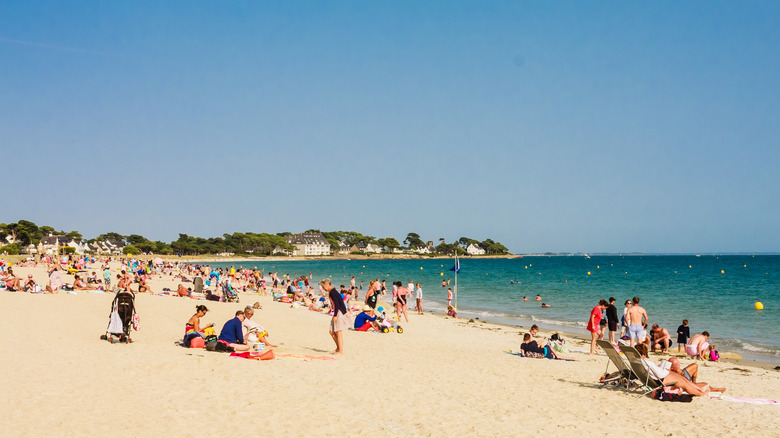France's Version Of Stonehenge Has White Sand Beaches, Mysterious Ancient Monoliths, And A Quaint Coastal Village
While some might consider the lichen-covered monoliths at Stonehenge to be one of the most disappointing monuments in the world, it's certainly not the only one of its kind. Across the English Channel on the coast of Brittany in France, a ring of megalithic boulders and burial mounds have quietly observed the passage of time for 7,000 years. Called the Carnac Stones, this prehistoric site can be found near the seaside village of Carnac, a charming community along the Gulf of Morbihan boasting cozy brick cottages and yachts bobbing in the harbor.
Unlike Stonehenge, however, the massive rocks at Carnac number nearly 3,000 in total, and aren't limited to circular formations. Instead, endless rows of craggy boulders stretch onwards for miles across serene grassy meadows as far as the eye can see. The standing stones are called menhirs, and a popular legend says they were soldiers of a Roman army who were frozen in stone. But like Stonehenge, nobody truly knows why the Carnac Stones were built and for what purpose, but common theories suggest a religious site, or even an astronomical calendar. The mystery merely adds to the aura, as you wander between the standing stones towering over the moors and try to imagine the prehistoric peoples who once found purpose here.
There's more to Carnac than just these ancient megaliths, though. If you're not keen on rock formations, kick off your shoes and head to Carnac's glittering beaches instead. Boasting powdery sand and aquamarine waves, you could spend a whole day just soaking up the dazzling French sunshine. Then, head into the village to find a scrumptious meal (foodies should check out the oyster farms), indulge in a little retail therapy at the charming boutiques and souvenir shops, or simply take a leisurely stroll through the quaint streets.
Explore the Carnac Stones and the coastal town
There's no charge to visit the Carnac Stones from October until March, but paid tours are available at other parts of the year. There are two main sites, Ménec and Kermario, where you can wander and get close to the rugged stones. Before you head out into the fields, first stop at the House of Megaliths, a visitor's center which acts as an introduction to the stones. Digital displays give a timeline of the monolith's construction (between 5,000 and 3,000 B.C.), and how the monuments may have been built. Grab a site map and an explanatory brochure, then take a stroll along the hiking trails that weave between the gargantuan crags. An unmissable landmark is the Tumulus of Saint-Michel, a colossal burial mound rising to 32 feet and topped by a stone chapel. Crest the mound to enjoy panoramic views of the Carnac Stones below and the seaside in the distance.
Once you've had your fill of the ancient megaliths, it's time to explore the beaches. The main shore, the Grande Plage de Carnac, is a blissful slice of white sand and turquoise surf calm enough for even young children to splash and play. Even better, the crystalline sand is perfect for building sand castles. And just down the coast is the Saint-Colomban Beach, where outdoor enthusiasts will find excellent opportunities for windsurfing and snorkeling.
Meanwhile, the Museum of Prehistory in the town center is also a fascinating diversion. Explore the exhibits detailing the evolution of primitive societies from the Paleolithic and Neolithic Ages all the way to the Iron Age and the Roman period. Get lost in the displays of ancient artifacts like stone tools and flint weapons, skeletal remains, and beaded jewelry. Tickets are around $8, an affordable price for such a vast museum.
Getting to Carnac and where to stay
If you're coming from Paris, high-speed trains leaving Montparnasse Station will take you to a town called Auray in less than three hours, where you can hire a taxi for the remaining 15- to 20-minute drive to Carnac. If you decide to drive, you could also add more stops to your Brittany travel plans with a visit to Dinan, an impeccably preserved medieval city about two hours northwards. Only a little further (and slightly off to the northwest) is also Perros-Guirec, an artsy seaside resort town surrounded by pink granite cliffs. Traveling from England, you can take a ferry from the port city of Plymouth across the sea to Roscoff in the north of Brittany, and Carnac is another two and a half hours' drive away.
Since Carnac is a trendy resort town, there are plenty of great accommodation options for your trip. The delightful Hôtel Le Diana is a stylish resort just steps away from the beach. Rooms are spacious and airy with floor to ceiling windows, a balcony with sweeping sea views, and elegant furnishings. The hotel can arrange private boat tours and beach picnics for an extra cost, and the Le Diana restaurant offers excellent French cuisine.
Another great option is the Le Celtique & Spa Hotel, also just a short walk from the Grand Plage de Carnac. This sprawling chalet-style resort boasts a heated indoor pool with extensive spa facilities, including a sauna and hammam. When you're not relaxing in one of the 53 opulent suites, find yourself at the gourmet bistro, Le Cairn, for a bite of fresh seafood, or enjoying drinks at the Boudicca Bar, which comes with an outdoor terrace for al fresco dining. But whether you're in Carnac to experience a mysterious ancient monument or catch some waves, get ready for a relaxing adventure.


